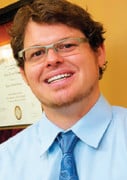Drs. Geoffrey Skinner and Joseph Zelk discuss the benefits of dentists partnering with a medical sleep specialist for a more efficient workflow that results in shorter time from screening to treatment.

by Drs. Geoffrey Skinner and Joseph Zelk
Has your dental sleep practice ever been slowed down by sleep clinics taking so long to get your patients studied, interpreted, and sent back for treatment? It sure frustrated me until I found a way around this problem by bringing a sleep clinic into my general dental practice, Hillsboro Dental Excellence, outside of Portland, Oregon. By partnering with Dr. Joseph Zelk, a board-certified sleep specialist that is licensed in Oregon and Washington, I made the process easy.
Dr. Zelk owned a sleep practice in Portland and had an active base of over 15,000 patients, so he needed me, too. I was drawn to bring Dr. Zelk into my practice because he is a champion of alternative therapies to CPAP, like mandibular advancement devices, Nightlase, and other therapies that can be done only by dentists. We both have a passion for helping patients get the best treatment options available for their specific needs. Working with Dr. Zelk, I can efficiently and affordably screen, test, diagnose, and obtain letters of medical necessity for alternatives to CPAP, often within one week. Since integrating a sleep specialist service into my practice, I have been able to screen and diagnose 6 patients per week on average. This allows me to keep the excitement going with the patient and not watch them fall off like other patients who depend on the traditional sleep referral process. In many communities, it can take months just to get a sleep test! Our process and work flow is so efficient that Dr. Zelk and I train dental offices through the AIR Institute, and have shared this system with many offices throughout the country.
Building trust between a dentist and a sleep physician means sharing reliable data. We chose a high-quality true Type II sleep testing device (Zmachine Synergy) and its shared inter-office portal so we could have confidence our patients were not being shortchanged. Between the CBCT, comprehensive photograph series, intraoral scans, and a Type II sleep test device, we are able to gather enough data to make not only a sleep breathing diagnosis, but to have a good understanding of which treatment modalities may work for the patients who do not wish to use CPAP. The Zmachine portal allows for the screening, sleep records and images to be shared among the dental office, the sleep specialist, and other collaborators (e.g., ENT, oral surgeon, myofunctional therapist) to provide our patients with truly collaborative, multidisciplinary care.
The Zmachine Synergy is a nine-channel Type II home sleep test (HST). I chose the Zmachine because it is easy to use by the patient and provides more clinical data than other devices while also being very affordable for the dentist. I did not need to sacrifice data for cost. The single-channel three-lead EEG provides a true AHI by recording the actual sleep time. Due to its affordability, I also use the Zmachine for titration. The combination of working closely with a local sleep physician and the many benefits that the Zmachine Synergy provides allows Dr. Zelk and I to screen and treat patients more efficiently and affordably. More people are breathing better during sleep – that’s what it’s all about.
Pat McBride also recommends partnering with a medical sleep specialist. Her article offers guidance on how to partner with different types of doctors. Read “Can Physicians and Sleep Dentists Create Lasting Symbiotic Relationships?” at https://dentalsleeppractice.com/2676/.


 Dr. Geoffrey Skinner is a key opinion leader and board member of the American Academy of Clear Aligners, a Diplomate of the American Board of Dental Sleep Medicine, a Winner of the Invisalign Reingage Doctor of the Year, and the creator of six top-selling and top-rated dental apps used by over 150,000 dentists worldwide. Dr Skinner is a diamond Invisalign provider and key opinion leader for Candid Pro and Fotona. Dr. Skinner practices with Dr. Joe Zelk on the west side of Portland, Oregon.
Dr. Geoffrey Skinner is a key opinion leader and board member of the American Academy of Clear Aligners, a Diplomate of the American Board of Dental Sleep Medicine, a Winner of the Invisalign Reingage Doctor of the Year, and the creator of six top-selling and top-rated dental apps used by over 150,000 dentists worldwide. Dr Skinner is a diamond Invisalign provider and key opinion leader for Candid Pro and Fotona. Dr. Skinner practices with Dr. Joe Zelk on the west side of Portland, Oregon.  Joseph Zelk, DNP, FNP, BC, CBSM, DBSM, D.ABDSM, is double board certified in Behavioral Sleep Medicine. Dr. Zelk is currently licensed in Oregon and Washington providing sleep specialist services to dental sleep medicine offices in both states. He has nearly 20 years of experience treating patients with PAP therapies and oral appliance therapy. He has contributed to patented oral appliance technologies; is creator and early adopter of combination therapies to improve patient adherence to PAP therapies; and coined the use of Hybrid Positive Airway Pressure (HPAP) therapies. He is currently lecturing nationally on sleep disorders and consulting on new FDA clearance projects for novel OSA treatments.
Joseph Zelk, DNP, FNP, BC, CBSM, DBSM, D.ABDSM, is double board certified in Behavioral Sleep Medicine. Dr. Zelk is currently licensed in Oregon and Washington providing sleep specialist services to dental sleep medicine offices in both states. He has nearly 20 years of experience treating patients with PAP therapies and oral appliance therapy. He has contributed to patented oral appliance technologies; is creator and early adopter of combination therapies to improve patient adherence to PAP therapies; and coined the use of Hybrid Positive Airway Pressure (HPAP) therapies. He is currently lecturing nationally on sleep disorders and consulting on new FDA clearance projects for novel OSA treatments.